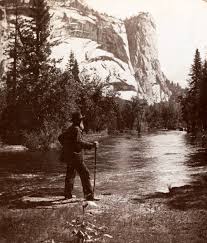
John Muir
Conservationist
John Muir (April 21, 1838 – December 24, 1914) was a Scottish born American conservationist. He wrote many works with the purpose of conserving nature and wilderness to prevent commercialization of what he believed to be an extension of God. Muir worked politically through his writings to ensure the preservation of nature. Muir’s work led to the creation of the American national parks and nature being central to the American spirit.
John Muir was a man of nature at heart whose dream was to seek “any place that is wild”. This Scottish born American naturalist is one of the reasons we still have the magnificent forests and natural wonders that populate the U.S. He was a naturalist, writer, and conservationist who was determined to preserve the natural beauty of America. Muir was directly responsible for the creation of 13 national forests including Sequoia National Park and Yosemite National Park and indirectly responsible for many more. His parks get millions of visitors a year and have inspired all kinds of artwork. Muir was a proponent of the naturalist community and was beloved by many in the community. His work raised awareness for environmental issues and was crucial to the conservationist movement at large. Muir shaped how American’s related themselves to nature. The landscapes that Muir has protected will be appreciated and will flourish for generations to come.
John Muir was born in Dunbar, Scotland on April 21, 1838. His home life was rough as his father was a cruel to him while he was a kid. He lived out a good portion of his childhood there, not emigrating to the U.S. until he was about 11 where he lived in a farm near Portage, Wisconsin. Then at 22 Muir attended The University of Wisconsin for 3 years where he studied geology and botany. In about 1867 he was in an industrial accident which blinded him for months and nearly cost him an eye. This led to a change in Muir and his love and devotion to nature.
The year after the accident Muir walked all the way from his home in the Midwest to the Gulf of Mexico. He kept his travels in a journal which was published two years after his death called “A Thousand Mile Walk to the Gulf”. He then sailed his way to California and walked from San Francisco to the “Range of Light” leading to his “unconditional surrender” to nature itself. Muir traveled all over the west including Nevada, Utah, Oregon, Washington, and Alaska. He had a great interest in glaciers and forests and published articles in Overland Monthly from 1874-75. He even came up with the theory that Yosemite formations were caused by glacial erosion, a theory that holds up to this day. Muir was spiritually connected to mother nature and realized that man is just a piece of the natural world and although we act like its master we are not. He also believed the way God revealed himself is through nature.
Muir was a crucial figure in the debate over land use. Most people believed that land had a specific purpose whether it be residential, agricultural, or commercial. John Muir had a different view on this and thought that some land should just be left in its natural state remaining untouched by society. Muir took action as early as 1876 urging the government to adopt a conservationist stance on policy. On May 28, 1892 he founded the Sierra Club, a prominent conservation organization that is still active to this day. Muir continued to raise awareness and persuade others to become conservationists through his writings. He went to the government to convince them to set aside land to be preserved for future generations.
In 1897 Muir convinced U.S. President Grover Cleveland to designate 13 national forests that were protected by the federal government. Congress postponed the effect of these measures due to commercial business interests. Muir fought back against this the only way he knew how, by writing. He was able to sway public and congressional opinion in his favor. Later he influenced a large-scale conservation program that was initiated by President Roosevelt. Muir even went on a camping trip to Yosemite with Roosevelt in 1903. During this trip Muir was able to convince Roosevelt to add Yosemite Valley and the Mariposa Grove to federal protection. His last act was to try to prevent a dam in Yosemite’s Hetch Hetchy Valley which was approved in 1913. He died on December 24, 1914 at the age of 76 of pneumonia.
